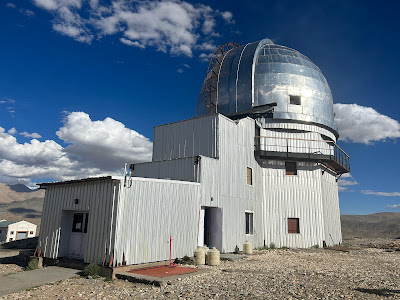"Day 6: Exploring Leh - From Confluences to Memorials, A Day Packed with Diversity
Dated 3rd August 2023
We began Day 6 by heading to Sangam, the confluence of the Indus and Zanskar rivers. One river carries with it the anger, its waters a fiery red, while the other symbolizes maturity and a cultured civilization, with its serene and composed flow. This geographical phenomenon underscores why civilizations develop around riverbanks—Indus absorbs the turbulent Zanskar, maintaining its own tranquility. Sangam is a mere 35 km from Leh city. On the return route, you'll also find the divine "Patthar Sahib Gurudwara," where Guru Nanak defeated a demon. The place exudes calmness and stands out distinctively from its surroundings. You can partake in "Prasad" or enjoy the "Langar" (community meal). We spent an hour absorbing the positive energy of nature at Sangam—unlimited positivity that creates more the more you embrace it. That hour was truly splendid, with a picture-perfect scene of a river flowing beneath a clear sky against the backdrop of vast mountains.
After immersing ourselves in nature's beauty, visiting the Gurudwara was the next step in mental relaxation. The land of Kashyap Rishi is not just about adventure or travel; it houses pockets of divine tranquility. Amid the ongoing cross-border turmoil and conflict, discovering such natural calm and peace is a blessing. From the Gurudwara, we moved on to Magnetic Hill, a place that often makes it to must-visit lists when discussing Ladakh. To be perfectly honest, however, I didn't find it particularly impressive. While it might have some natural significance, it's not as awe-inspiring as it's often portrayed. Since it's along the return route, you can judge it for yourself, but personally, I don't think it lives up to the hype.
 Having concluded our magnificent journey to Sangam Point and the Gurudwara, we then visited the heart of the city, a small fort known as "Zorawar Fort," named after General Zorawar from the Dogra dynasty—a Rajput ruler who governed the region and successfully defended it against Tibetan, Chinese, and Russian political advances of that era. General Zorawar is credited with his mountain warfare expertise. His strategic acumen and bravery have secured Ladakh and parts of Baltistan as Indian territory. Although his name is less commonly known, his contributions to Indian territory during the British colonial era are profound. Some might not recommend visiting the fort due to its limited attractions, but if you're a history enthusiast seeking deeper insights, it's worth a visit.Our day was entertaining, encompassing geography, history, the Magnetic Hill phenomenon, and the divine serenity of the Gurudwara. We also managed to squeeze in some repair work at the Royal Enfield showroom, which was necessary before our upcoming adventure over the next five days.
Having concluded our magnificent journey to Sangam Point and the Gurudwara, we then visited the heart of the city, a small fort known as "Zorawar Fort," named after General Zorawar from the Dogra dynasty—a Rajput ruler who governed the region and successfully defended it against Tibetan, Chinese, and Russian political advances of that era. General Zorawar is credited with his mountain warfare expertise. His strategic acumen and bravery have secured Ladakh and parts of Baltistan as Indian territory. Although his name is less commonly known, his contributions to Indian territory during the British colonial era are profound. Some might not recommend visiting the fort due to its limited attractions, but if you're a history enthusiast seeking deeper insights, it's worth a visit.Our day was entertaining, encompassing geography, history, the Magnetic Hill phenomenon, and the divine serenity of the Gurudwara. We also managed to squeeze in some repair work at the Royal Enfield showroom, which was necessary before our upcoming adventure over the next five days. While Thiksey Monastery, Leh Palace, and the "3 Idiots" famous school were on our list, we decided to postpone these visits to our final day in the Ladakh region. Now was the time to visit the Leh Hall of Fame, a memorial dedicated to the martyrs who sacrificed their lives defending India's borders in various encounters. It's a place of profound significance, not solely for its structure or the quality of its museum, but for the documentary that's screened each evening. Visiting the Hall of Fame isn't just about appreciating the site; it's about paying tribute and showing respect for each Indian soldier. The Kargil War Memorial in Kargil and this one in Leh have distinct locations and displays, but they share a common emotion. These war memorials aren't tourist spots; they're sacred grounds representing the highest form of sacrifice for the country.
The 8-minute documentary or laser show evokes goosebumps as it narrates stories of ultimate sacrifice, leaving you profoundly moved. Many of us carry those emotions for a short while, while others might forget by the next day. For many, a sense of pride becomes a luxury celebrated on Independence Day and Republic Day, but we often fall short in comparison to the sacrifices made. Acknowledging this reality is crucial.
Day 6 concluded on that note, and we began preparing for Day 7—an adventure-filled day that required packing up our luggage that had been spread out for two days. It was a heavy realization for me, as I realized that I had unknowingly packed excessive clothes and luggage. It took nearly two hours to repack everything.
Our day was jam-packed, offering a taste of Leh city's offerings—although we had only covered half of it. Stay tuned for Day 7.




















Comments
Post a Comment